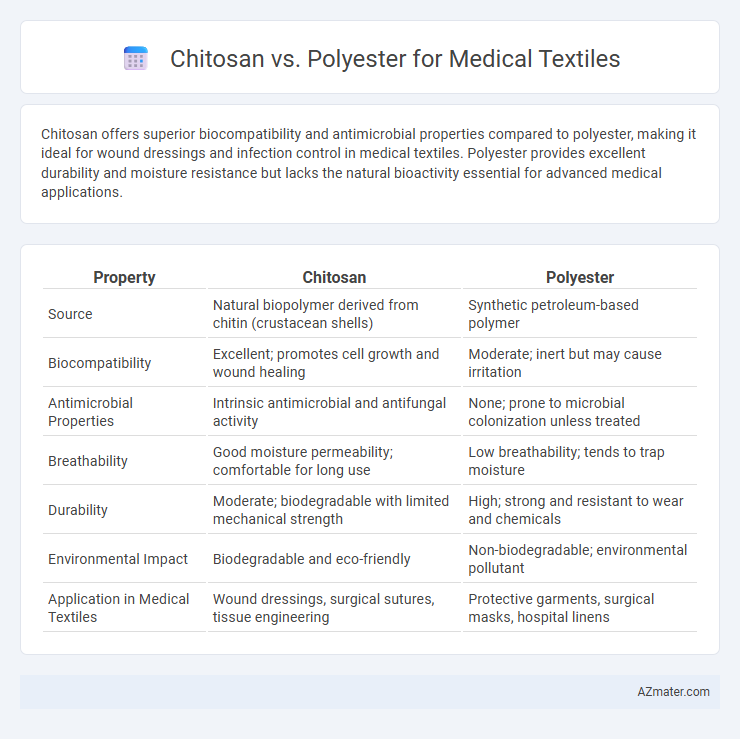Chitosan offers superior biocompatibility and antimicrobial properties compared to polyester, making it ideal for wound dressings and infection control in medical textiles. Polyester provides excellent durability and moisture resistance but lacks the natural bioactivity essential for advanced medical applications.
Table of Comparison
| Property | Chitosan | Polyester |
|---|---|---|
| Source | Natural biopolymer derived from chitin (crustacean shells) | Synthetic petroleum-based polymer |
| Biocompatibility | Excellent; promotes cell growth and wound healing | Moderate; inert but may cause irritation |
| Antimicrobial Properties | Intrinsic antimicrobial and antifungal activity | None; prone to microbial colonization unless treated |
| Breathability | Good moisture permeability; comfortable for long use | Low breathability; tends to trap moisture |
| Durability | Moderate; biodegradable with limited mechanical strength | High; strong and resistant to wear and chemicals |
| Environmental Impact | Biodegradable and eco-friendly | Non-biodegradable; environmental pollutant |
| Application in Medical Textiles | Wound dressings, surgical sutures, tissue engineering | Protective garments, surgical masks, hospital linens |
Introduction to Medical Textiles
Medical textiles integrate advanced materials designed to improve patient care and health outcomes through enhanced biocompatibility and functionality. Chitosan, a natural biopolymer derived from chitin, offers antimicrobial properties, biodegradability, and excellent wound healing capabilities, making it a promising alternative to synthetic fibers like polyester. Polyester provides high mechanical strength, durability, and resistance to chemicals, but lacks the inherent bioactive properties that chitosan delivers for medical applications such as wound dressings and tissue engineering scaffolds.
Overview of Chitosan as a Medical Textile Fiber
Chitosan, a biopolymer derived from chitin in crustacean shells, offers exceptional antimicrobial, biocompatible, and biodegradable properties, making it ideal for medical textile applications such as wound dressings and surgical sutures. Its natural ability to promote cell growth and accelerate healing distinguishes it from synthetic fibers like polyester, which lack inherent bioactivity and biodegradability. The integration of chitosan in medical textiles enhances infection control and supports tissue regeneration, addressing critical needs in advanced healthcare products.
Properties and Benefits of Polyester in Medicine
Polyester in medical textiles offers exceptional durability, resistance to chemicals, and excellent moisture-wicking properties, making it ideal for reusable surgical gowns and patient garments. Its inherent strength and quick-drying capability enhance hygiene by reducing bacterial growth and contamination risks during medical procedures. Compared to chitosan, polyester provides superior mechanical stability and cost-effectiveness, ensuring longevity and reduced maintenance in healthcare environments.
Biocompatibility: Chitosan vs Polyester
Chitosan exhibits superior biocompatibility compared to polyester due to its natural origin and inherent antimicrobial properties, reducing the risk of inflammation and promoting wound healing in medical textiles. Polyester, a synthetic polymer, often triggers foreign body reactions and lacks biodegradability, limiting its integration with biological tissues. The enhanced cell adhesion and non-toxic degradation of chitosan make it a preferred choice for medical applications where biocompatibility is critical.
Antimicrobial Activity Comparison
Chitosan exhibits superior antimicrobial activity compared to polyester due to its inherent biopolymer structure that disrupts microbial cell membranes and inhibits bacterial growth effectively. Polyester lacks intrinsic antimicrobial properties, often requiring chemical treatments or coatings to achieve similar pathogen resistance. The natural biodegradability and non-toxic nature of chitosan enhance its functionality as a preferred antimicrobial agent in medical textile applications, promoting infection control and patient safety.
Mechanical Strength and Durability
Chitosan fibers exhibit excellent biocompatibility and antimicrobial properties but generally have lower mechanical strength and durability compared to polyester fibers, which are known for their high tensile strength and long-lasting performance in medical textiles. Polyester offers superior resistance to stretching, abrasion, and chemical degradation, making it ideal for reusable medical garments and wound dressings requiring durability. Despite its lower strength, chitosan's biodegradability and natural origin provide advantages in applications prioritizing environmental sustainability and biological function over prolonged mechanical use.
Breathability and Comfort in Medical Applications
Chitosan fibers exhibit superior breathability and moisture-wicking properties compared to conventional polyester, enhancing patient comfort in medical textiles. The natural antimicrobial and hypoallergenic characteristics of chitosan contribute to reducing skin irritation and infections, crucial for wound dressings and surgical gowns. Polyester, while durable and cost-effective, often lacks the permeability and biocompatibility needed for sensitive medical environments, making chitosan a preferred choice for advanced therapeutic applications.
Environmental Impact and Sustainability
Chitosan, derived from renewable crustacean shells, offers superior biodegradability and antimicrobial properties, making it an eco-friendly alternative to conventional polyester in medical textiles. Polyester, synthesized from petroleum-based resources, contributes significantly to microplastic pollution and has a slower degradation rate, raising environmental concerns in medical waste management. Utilizing chitosan enhances sustainability by reducing reliance on fossil fuels and minimizing ecological footprints in healthcare applications.
Cost and Scalability for Healthcare Use
Chitosan fibers, derived from crustacean shells, offer excellent biocompatibility and antimicrobial properties but tend to be higher in cost due to complex extraction and processing methods compared to synthetic polyester fibers. Polyester, widely used in medical textiles, provides superior scalability with established large-scale production facilities and lower unit costs, making it more accessible for mass healthcare applications. Cost-effective polyester enables broad application across disposable medical products, whereas chitosan's scalability challenges limit its use to specialized, high-value medical textiles.
Future Trends in Medical Textile Development
Chitosan, a biocompatible and biodegradable polymer, is gaining traction over polyester due to its antimicrobial properties and enhanced wound healing capabilities in medical textiles. Future trends indicate a shift towards integrating chitosan with smart textile technologies, such as sensor-embedded fibers, to enable responsive and adaptive medical garments. Innovations in sustainable production methods and multifunctional textile composites are set to drive the adoption of chitosan-based materials, surpassing traditional polyester fibers in healthcare applications.

Infographic: Chitosan vs Polyester for Medical Textile
 azmater.com
azmater.com